Cracking The Code of CompareTheMarket’s Winning SEO Strategy
- August 3, 2023

Have you ever wondered how websites dominate search engines for specific keywords? Maintaining a strong online presence is key for businesses of all sizes. One company you will have most likely heard of or even used is CompareTheMarket.
CompareTheMarket is a well-known insurance comparison site, who have managed to make a real name for itself in the insurance industry. Their company name resonates with millions of consumers in the UK. They have successfully cracked the code by achieving the ultimate SEO marketing strategy to drive organic and paid traffic to their website.
In this post, we will delve into the secrets behind this incredible SEO strategy. From keyword implementation to link building, we will uncover the tactics and techniques that have boosted CompareTheMarket’s online presence.
Whether you are an aspiring marketer looking to learn more about successful SEO strategies or simply curious, come along on the journey to unlock the mysteries behind CompareTheMarket’s SEO triumphs.
See how you too can create a winning financial SEO strategy!
CompareTheMarket’s Basic SEO Metrics

For this analysis, we will be using SEMrush.
From the image above, you can see that CompareTheMarket has an authority score of 73. Normally, we don’t measure a website through this metric, but we can use it in this analysis as a comparative tool.
Domain authority on SEMRush is calculated by using link power, the amount of organic traffic and a website’s natural profile. The result is a number from 0-100, with the latter being the best authority score a website can achieve. Please note, that this is not a Google ranking factor!
With 5 million monthly organic users landing on this website through over 266.7k UK keywords, it’s no shock that CompareTheMarket is steaming ahead in SEO for insurance companies.
With 11.9 million backlinks from over 21.5k domains, they have generated relevant and authoritative content that other websites want to link to. We will discuss this in detail further in the blog.
Keyword Implementation
CompareTheMarket utilises a wide range of keywords targeting different stages of the funnel. Below, you can see a brief keyword overview of their SEO strategy.

In total, CompareTheMarket is ranking for 267.9k keywords. In this, 261.9k are unbranded, meaning users can find their website without using their brand name in the search query.
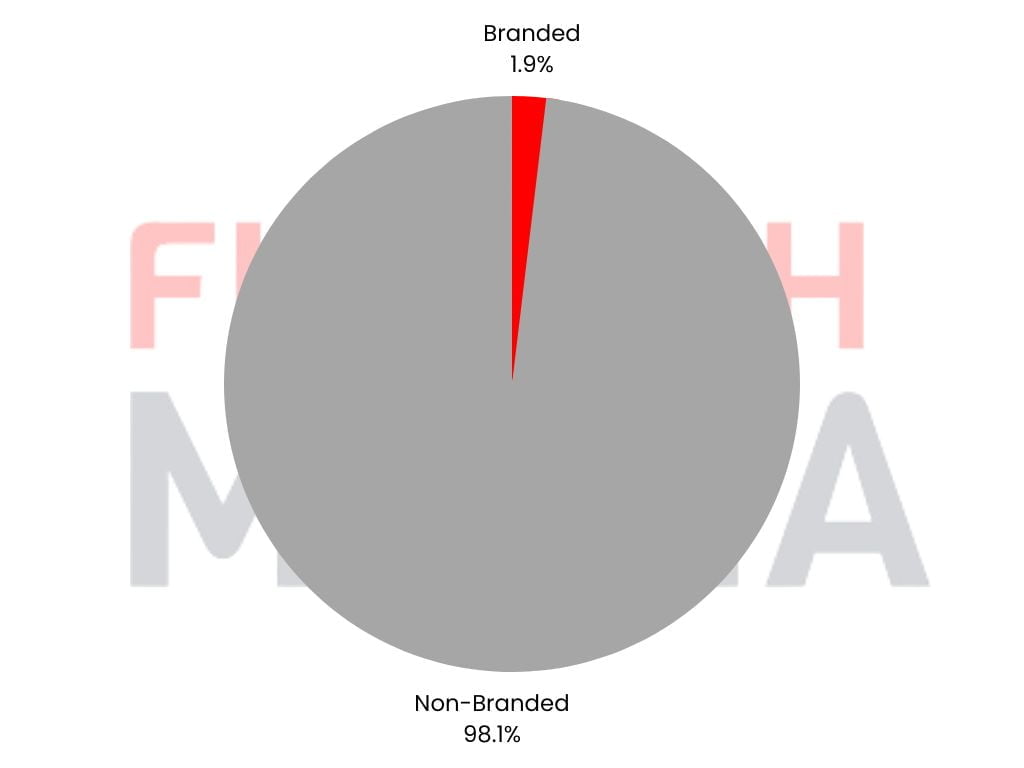
They manage to attract a large audience by utilising non-branded keywords. This audience reaches 5,100,000 users per month through organic search. If these users were generated through PPC means, it would cost roughly \$17.6m per month to develop the same kind of traffic that their SEO has resulted in.
CompareTheMarket strategically implements its main focus keywords. Their H1 titles are optimised so they are not the biggest titles on the page, which would be the norm.
Instead, on main pages like their Home Insurance landing page, the H1 titles are the smallest. See below the screenshot:
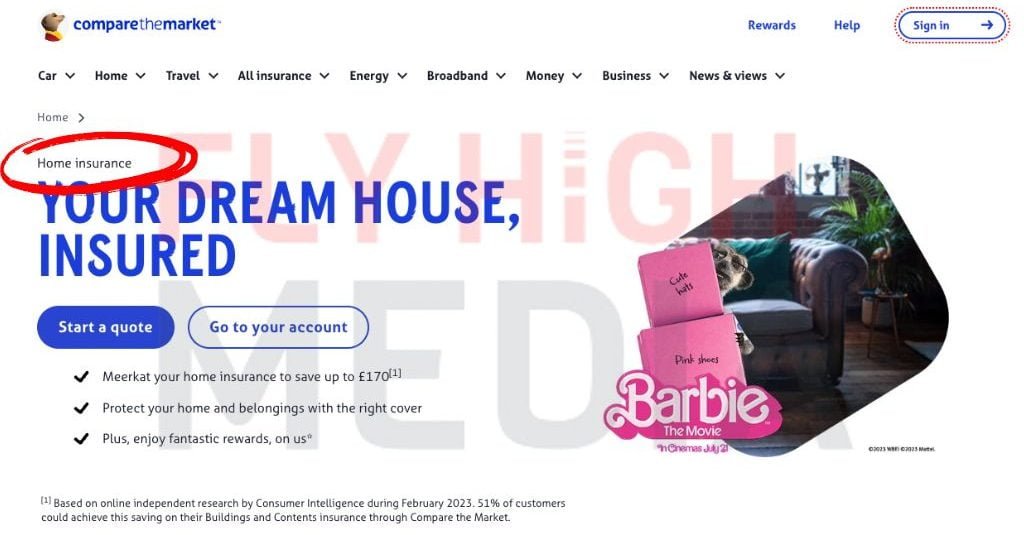
Above, you can see the H1 title circled. ‘Home Insurance’ has been placed in a prime position at the top of the page so the user can see they are still on the correct page. However, they have made the CTA the biggest feature on the page, attracting more users to perform an online quotation for home insurance. The main focus keyword being the H1 title is helping the page to rank for home insurance keywords, and the enlarged CTA is converting these users into customers.
As well as using keywords in the titles and content, CompareTheMarket have included an FAQ section at the bottom of each landing page. We will use the home insurance landing page for an example again.
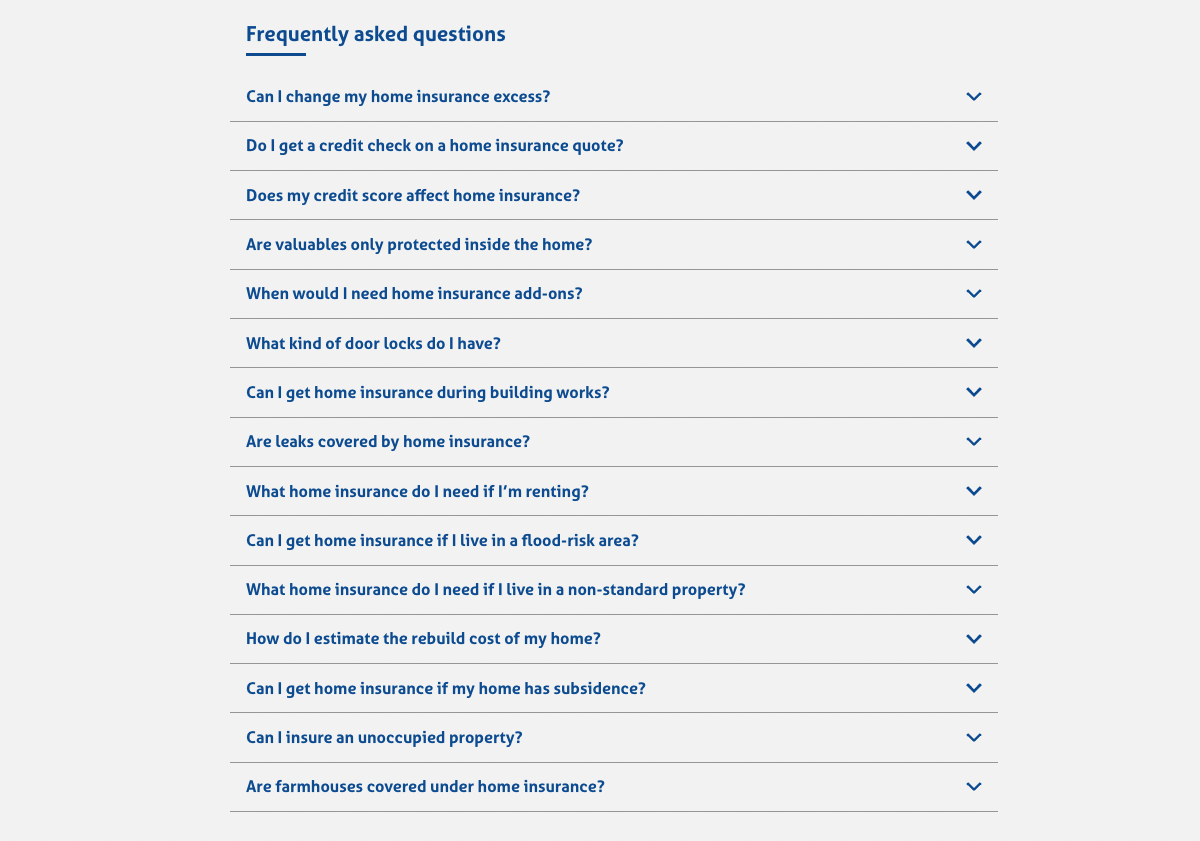
As you can see from the screenshot above, the FAQs included are questions that users would type in a search engine, like Google.
Answering questions like these can improve visibility in search engines, via featured snippets. After all, featured snippets account for 35.1% of all clicks on search engine results pages.
Their Backlink Profile Explained
With CompareTheMarket amassing a massive 11.4m backlinks on their website from 20.6k referring domains, it’s no surprise that this contributes to their successful SEO strategy.
Below is a graph showing their backlink profile since the website started. As you can see, there seems to have been a huge effort in terms of gaining backlinks to their website between January 2021 and March 2022. This led to an increase in backlinks of 261.17%.
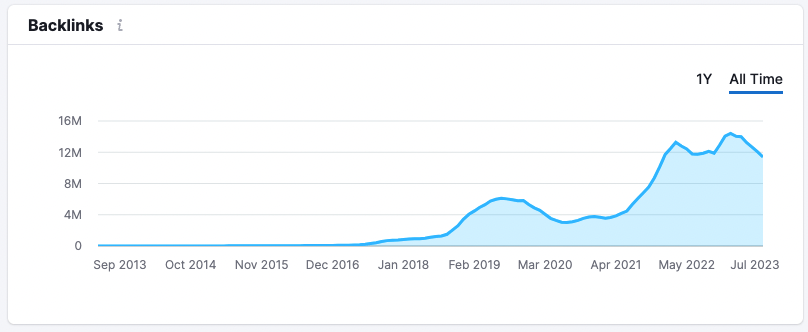
Let’s take a closer look at the previous year.
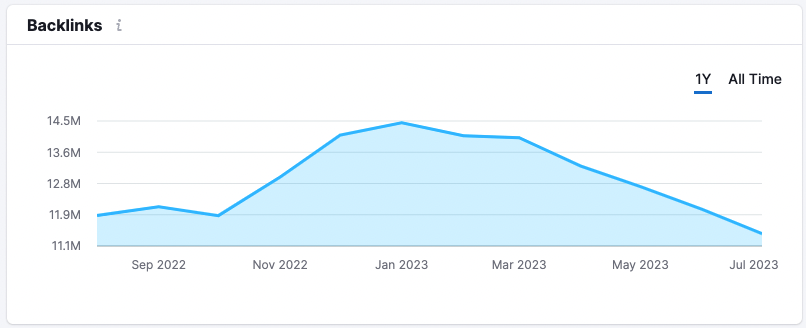
Recently, CompareTheMarket seems to have had a drop off in backlinks. This could be down to removing toxic backlinks by disavowing them or part of their overall SEO strategy.
From March 2023 to July 2023, there has been a decrease of 18% in the number of backlinks on the CompareTheMarket website.
Upon closer inspection, this decrease in the number of backlinks is the result of ComparetheMarket removing backlinks. For example, one referring domain, a used car dealership based in the UK, lost 549 links to CompareTheMarket’s website between March 2023 and July 2023. Removing these links could have been due to an issue with the referring website at the time like 404 pages.
This backlink disavowal process will refine the users further who land on their website, improving the conversion rate.
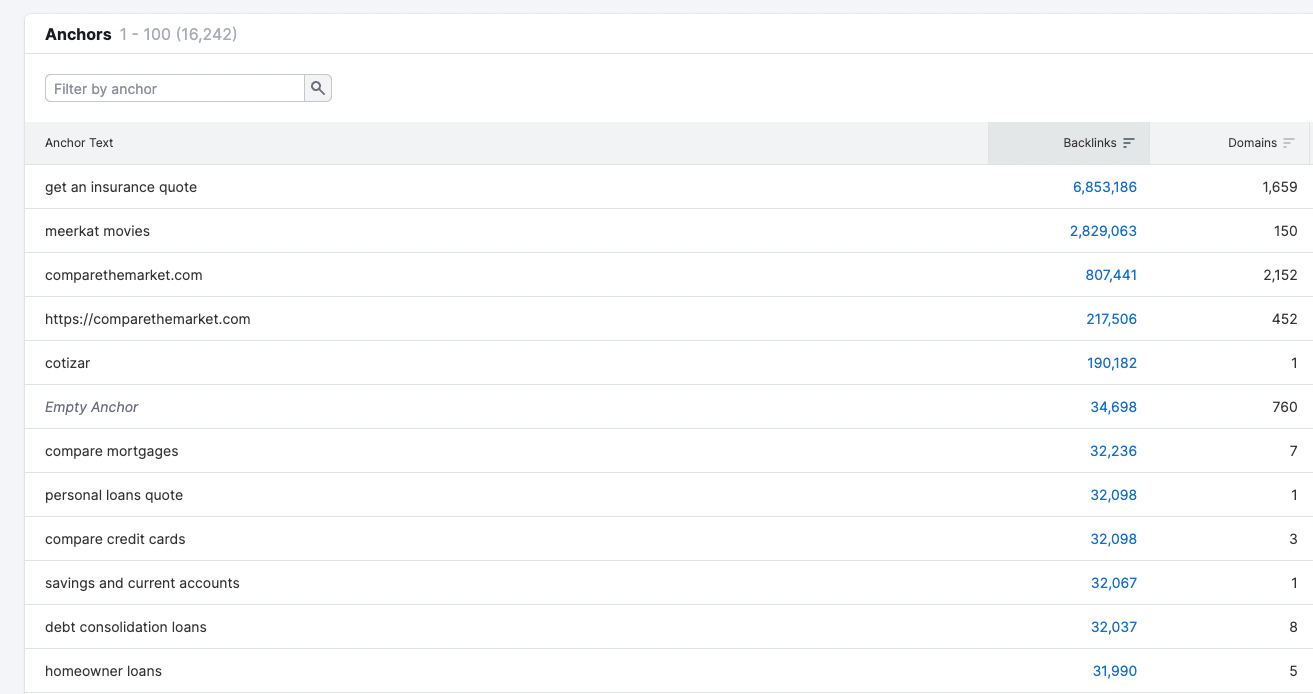 Website Vitals
Website Vitals
The page speed for CompareTheMarket is a little hit-and-miss. Whether it be on mobile or desktop, it is incredibly important to optimise websites to improve page speed. A few common issues which slows down page speed are:
- Unoptimised images
- Excessive HTTP requests
- Unclean code
- JavaScript issues
- Not utilising caching techniques
Page speed is one of the key factors Google considers in their latest algorithm, which can affect rankings in search results.
Let’s analyse the top 5 landing page URLs on CompareTheMarket to look at their page speed and any opportunities which may help improve speed.
URL | Mobile Speed | Desktop Speed | Opportunities |
|---|---|---|---|
Car insurance landing page | 75 | 98 | Reduce unused JavaScript and eliminate render-blocking resources
|
Home insurance landing page | 82 | 92 | Reduce unused JavaScript and eliminate render-blocking resources |
Broadband landing page | 78 | 92 | Reduce unused JavaScript, serve images in next-gen formats, properly size images, defer offscreen images and preload largest paint image |
Travel insurance landing page | 72 | 97 | Reduce unused JavaScript and defer offscreen images |
Energy landing page | 72 | 97 | Reduce unused JavaScript |
The Use of Structured Data
Structured data is coding which is implemented so search engines can understand your website content easier, and display this information in a rich or featured snippet. Using structured data is important to any industry, especially if you rely on organic search to generate leads and enquiries. As an example, we will use ComapreTheMarket’s travel insurance landing page. This page is currently utilising different types of structured data, such as:- Comment
- FAQPage
- BreadcrumbList
- FinancialProduct
- WebPage
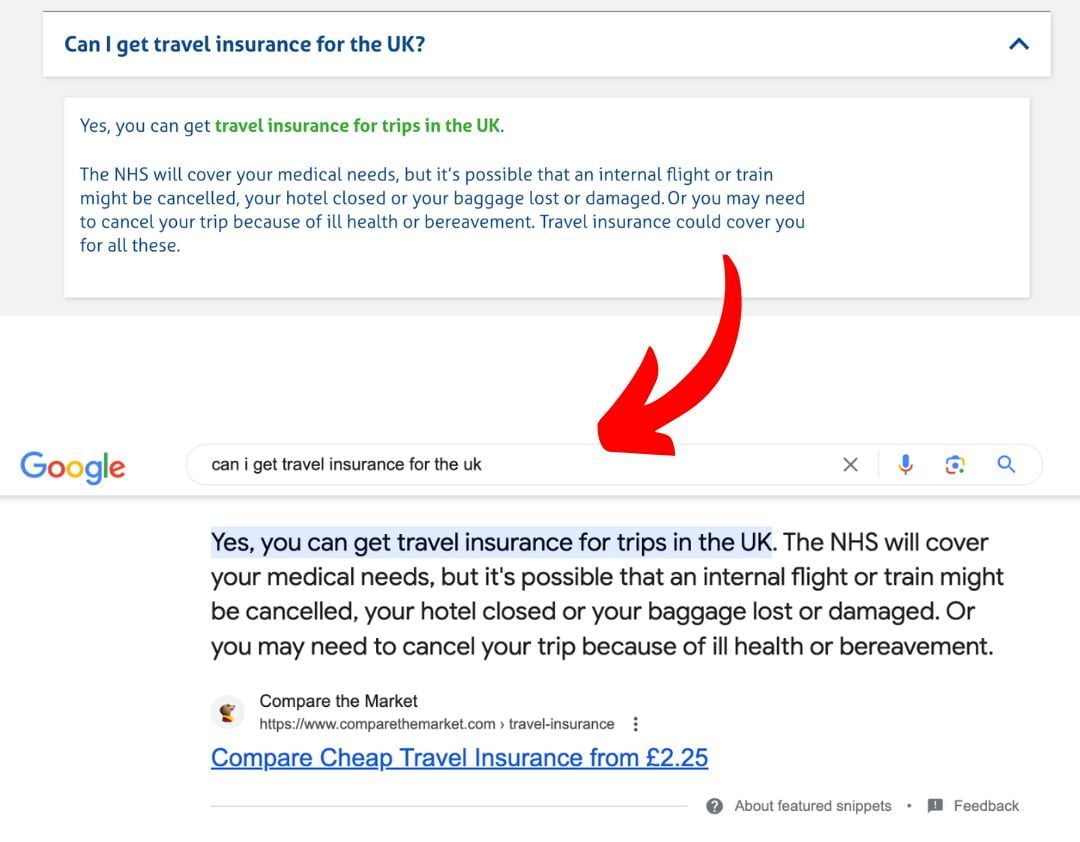 This would direct vast amounts of organic traffic to this landing page, increasing the number of conversions and sales. With CompareTheMarket also being a well-known brand now for comparing different types of insurance, the user would be more likely to click on this snippet as they trust this brand. Just to put a number on the success of this landing page from ComapreTheMarket, 300k organic users visit this page per month.
Scroll down to see how we think CompareTheMarket can improve its use of structured data!
This would direct vast amounts of organic traffic to this landing page, increasing the number of conversions and sales. With CompareTheMarket also being a well-known brand now for comparing different types of insurance, the user would be more likely to click on this snippet as they trust this brand. Just to put a number on the success of this landing page from ComapreTheMarket, 300k organic users visit this page per month.
Scroll down to see how we think CompareTheMarket can improve its use of structured data!
E-E-A-T and YMYL Considerations
YMYL stands for ‘Your Money or Your Life’ and covers anything that affects the health, well-being, safety and financial security of the target audience of pieces of content. In addition to this, EEAT stands for ‘Experience, Expertise, Authoritativeness and Trustworthiness’. You need to know that EEAT is not a ranking factor in Google, but a component of Google’s Search Quality Rater Guidelines to assess the expertise of content. CompareTheMarket regularly publishes written content in the form of guides and blog posts for users to find via search engines. However, instead of having one main blog page, they are separated into categories which can be found on the navigation bar under each insurance type. Anyone aged from 17 to 70 years and over may need to, at one stage, seek advice or help from CompareTheMarket, so their content needs to feel relevant and authoritative to audiences of different ages.E-E-A-T – Experience
CompareTheMarket releases written content about personal experiences from their content team. This provides unique insights into their opinions. Take the page ‘Meet The Experts‘ as an example. These experts provide insight into their knowledge of the background of CompareTheMarket and their relevant past jobs, giving the users confidence that these guides are coming from knowledgeable sources.E-E-A-T – Expertise
The authors of the guides and blog posts on CompareTheMarket must know their stuff to be published. For example, Felicity Hannah who is a Finance Expert, regularly publishes articles on CompareTheMarket’s website. In her author bio, she explains her past jobs working as a personal finance reporter for radio stations and on television. This bio also lists her impressive awards, such as ‘Household Money Journalist of the Year’. Users trust articles written by expert sources. This type of content can offer value to searchers and performs well under Google’s E-E-A-T.E-E-A-T – Authoritativeness
The authoritative section refers to the overall reputation of the relevant industry. Google’s quality raters are told to review the authoritativeness of the content creator and the website overall. Take the article ‘Can I take out a joint home insurance policy?‘ as an example. This is:- Featured on the home insurance content page
- Written by an insurance comparison expert
- Reviewed by an insurance and money expert
- Posted on a leading insurance comparison website
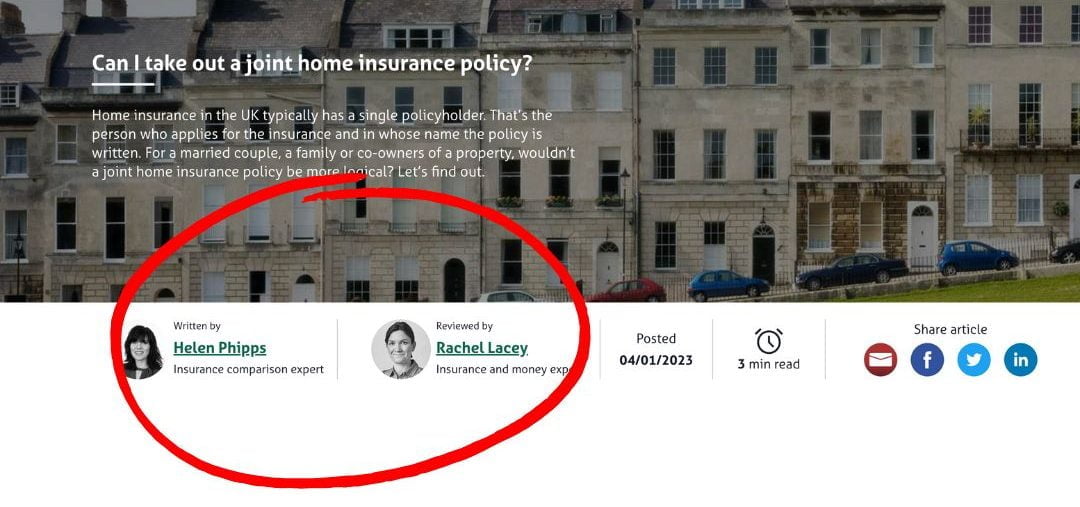
E-E-A-T – Trustworthiness
This is the most important part of Google’s E-E-A-T SEO. The Google quality raters must take into account the creator, content and website. CompareTheMarket uses trustworthy original research in their content and opinions from industry experts, increasing the amount of trust users have in their content and their brand. For example, take the post ‘How the rise in living cost is impacting the adoption of electric vehicles – a data-driven guide‘. This concerns sensitive subjects that the user may be experiencing, such as the cost of living crisis. For this to rank in Google, it must be deemed trustworthy by the search engine and contain factual information at the time of writing.Metadata Tactics
For users to click on CompareTheMarket in organic search results, they must have an enticing metadata strategy in place. Let’s use the most well-known type of insurance they compare – car insurance. The metadata for this page looks like this: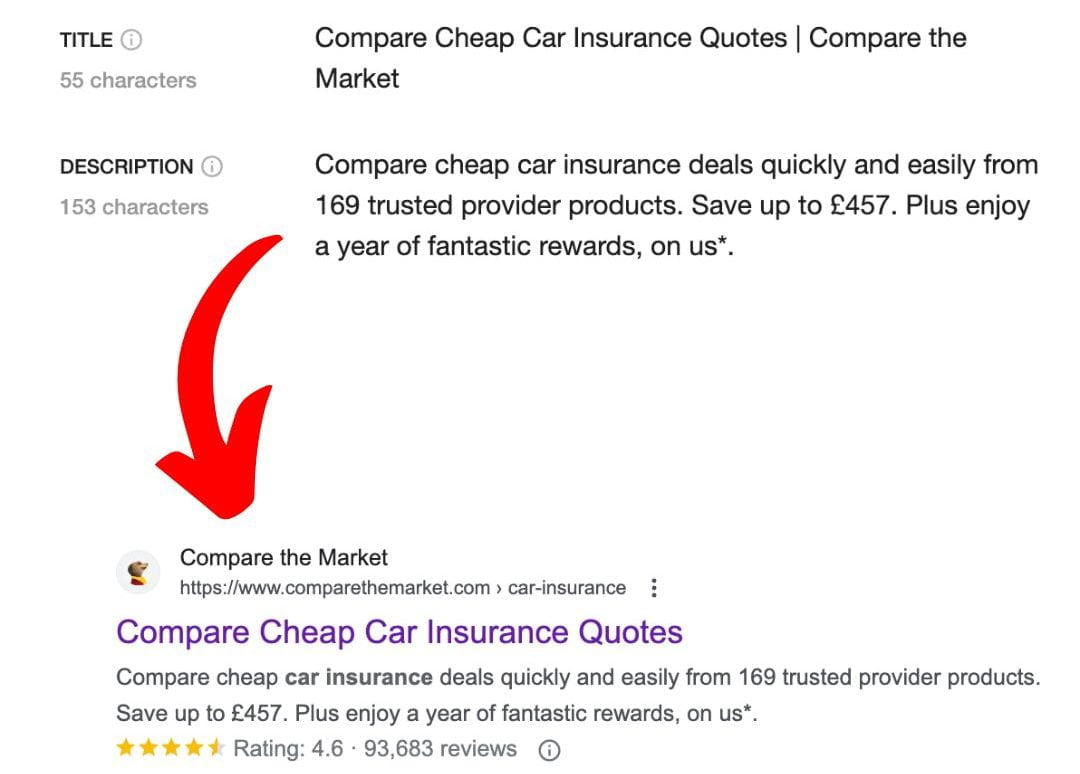 The top shows what the metadata looks like in a Chrome extension, and the bottom shows what a user would see in organic search results.
Notice how they include the price a user could save, not what the price starts at? That’s got to be attractive to a user. They strategically think about how they can adopt a user’s train of thought in what matters most to them when purchasing car insurance – cost.
They also use their target keyword in both the meta title and description. In this case, it would be ‘compare cheap car insurance’, which is what the user would search for.
Let’s look at how they adopt metadata strategies with blog posts with their ‘Annual vs Single Trip Insurance‘ post.
The top shows what the metadata looks like in a Chrome extension, and the bottom shows what a user would see in organic search results.
Notice how they include the price a user could save, not what the price starts at? That’s got to be attractive to a user. They strategically think about how they can adopt a user’s train of thought in what matters most to them when purchasing car insurance – cost.
They also use their target keyword in both the meta title and description. In this case, it would be ‘compare cheap car insurance’, which is what the user would search for.
Let’s look at how they adopt metadata strategies with blog posts with their ‘Annual vs Single Trip Insurance‘ post.
 Their meta title and description, again, both include a target keyword for the blog. In this case, it is ‘annual vs single tip travel insurance’ and ‘annual multi-trip or single-trip travel insurance’. The meta description is short and straight to the point for the user, containing a hook too. The hook makes it more likely for a user to click on their website in organic search results to find out more about the blog.
Their meta title and description, again, both include a target keyword for the blog. In this case, it is ‘annual vs single tip travel insurance’ and ‘annual multi-trip or single-trip travel insurance’. The meta description is short and straight to the point for the user, containing a hook too. The hook makes it more likely for a user to click on their website in organic search results to find out more about the blog.
How Can CompareTheMarket Improve Their Winning SEO Strategy Even Further?
1. Ensure All Relevant Schema Is Used
Upon further research of landing pages, it seems as though some are missing some valuable schema opportunities. Take their Buildings Insurance landing page as an example. When researching this URL, it is missing FAQ schema to help Google understand their FAQ answers in more detail. This page currently has comment, aggregate rating, breadcrumb, product and webpage schema, but not FAQ schema. CompareTheMarket – take note!2. Redirect Removed Blog Posts
When researching popular written content, we came across the post ‘How far can you drive once the fuel light comes on?‘, which leads to a 404 page. This is not good from a user perspective, especially if users are still finding this guide on the car insurance guides landing page! Below you can see where we found this link on the car insurance content page. CompareTheMarket, how are you going to keep users on your website if selected guides don’t work?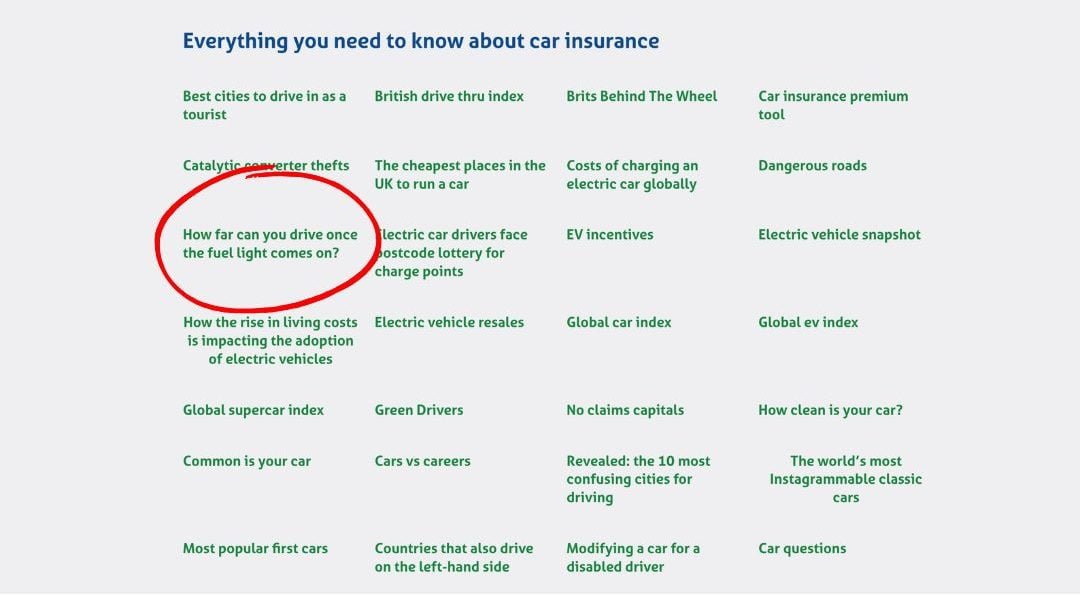 The image above shows where this post is located on their website.
A well-thought-out and planned SEO strategy can change your business. How can you adopt CompareTheMarket’s SEO strategy?
The image above shows where this post is located on their website.
A well-thought-out and planned SEO strategy can change your business. How can you adopt CompareTheMarket’s SEO strategy?
Contact Fly High Media today for assistance with SEO for your financial business!
Contact Us
Cheshire (Head Office)
Manchester
Get in touch
Let’s find the best solution for your business



